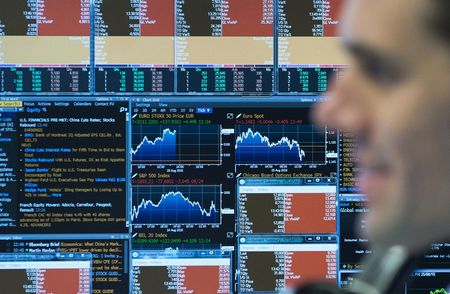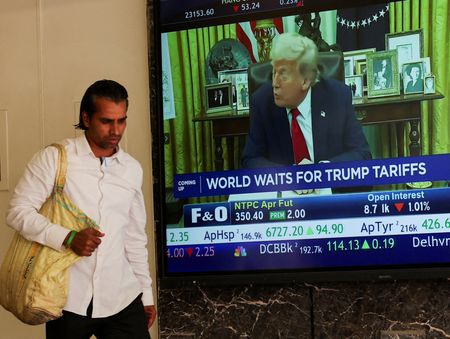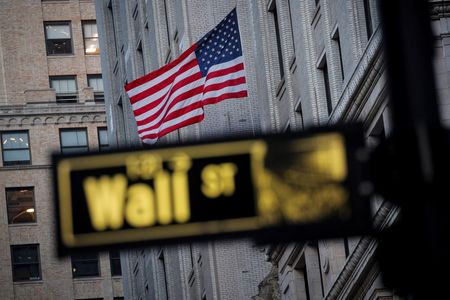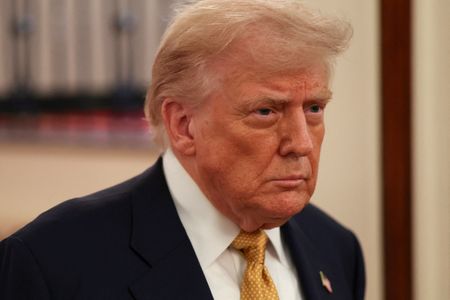By Laura Matthews
NEW YORK (Reuters) -Some U.S. companies are taking advantage of more attractive pricing in euro options to protect the revenues they expect from Europe against losses, fearing the common currency may have strengthened a bit too far.
The euro rose against the dollar after the U.S. rolled out larger-than-expected tariffs in April, knocking the buck to a three-year low and raising concerns about U.S. assets, its exceptionalism and economic growth.
That rationale is being challenged with U.S. stocks staging a 26% recovery from their April lows to rise 6.4% for the year, aided by postponements to the implementation of import tariffs, better-than-feared first-quarter earnings and positive economic data.
The options market reflects how investors and traders expect currencies to perform. Right now they are signaling less conviction in further dollar weakness, and some companies have been buying up euro put options that will appreciate if the euro weakens, to hedge their cash flow against euro weakness.
A weak euro could dampen earnings for U.S. companies if profits made overseas are repatriated at unfavorable exchange rates.
“Companies with euro revenues are saying, ‘we got a great run, let’s just make sure that we don’t get hit hard on the downside’,” said Eric Merlis, co-head of global markets, at Citizens in Boston, explaining some of his clients’ thinking.
“There is not as much conviction around a continued run in the euro, so a little bit of protection is helpful.”
Holders of put options have the right to sell the underlying currencies at a fixed price and date. They are typically bought to express a bearish view.
With currencies quoted in pairs, a bearish position on the euro indicates a view of dollar strength. Conversely, a euro call would gain value if the euro rises and is the same as a dollar put.
UNWINDING SHORT DOLLAR TRADES
Euro/dollar options activity continued to surge in June, with $803 billion notional reported, but down from the previous high of $907 billion in April, according to data from Clarus, an ION company.
Traders and advisors said over the past three weeks, U.S. corporates expressed more interest in euro puts to set up for future earnings, reversing some of the short dollar trades that populated the market since tariffs were announced.
Traders said the market sees a lid on the euro between $1.18 and $1.20, compared to its current level around $1.16.
“The options market is unwinding to a lot of the short dollar positioning,” said Garth Appelt, head of foreign exchange trading at Mizuho Americas, whose desk sold off all those trades last week.
“This whole theory of the U.S. exceptionalism not in play has not worked out since April,” he added. “The dollar should weaken for many reasons, which are very centric to the U.S., but we don’t have an alternative to growth pickup.”
COLLARS IN FASHION
Data from CME Group showed the bulk of demand has switched to euro puts so far in July. Since March there had been more interest in euro call options on the exchange.
Meanwhile, the over-the-counter market showed that euro calls made up 58.73% of euro/dollar options transactions in June, down from the high of 60% seen in April, according to Clarus data. Euro puts were 41.26% in June, up from 39.96% in April.
Paula Comings, head of FX sales at U.S. Bank, said some of her healthcare clients started using zero-cost collars in late June to shield the revenues from Europe as persistent strength in the U.S. economy and robust employment numbers continue to defy earlier concerns about U.S. exceptionalism.
In this case, the collars involve the sale of euro call options to finance the purchase of euro puts up to two years out.
As Comings explained, a company wanting to sell euros for dollars a year from now can lock in a forward rate of $1.188, or use a zero-cost collar to cap the range between $1.2518 and a worst case $1.1338. In late February, it could have locked in a forward of $1.058, or used a collar between $1.0991 and $1.0049.
“It’s really blown up in recent weeks. The dynamics are some of the best we’ve seen in 20 years,” said Comings. “We have several others that are noodling on this.”
Chris King, co-founder at advisory Dukes & King in London, is also seeing clients move to protect next year’s budget with some of these strategies.
“If you’re an American business, you haven’t previously had a favorable spot rate,” King said. “Now you’ve got the benefit of that spot move, combined with that yield curve benefit. So, if you’re a U.S. seller of euros you can get a very favorable profile, particularly if longer dated.”
The dollar has fallen 12% against the euro for the year.
With U.S. President Donald Trump delaying reciprocal tariffs to August 1, and remaining on the offensive with the European Union and other trading partners, currency markets could see more gyrations in coming weeks.
Conversely, Jackie Bowie, head of EMEA at Chatham Financial, a hedge adviser in the UK, said with the dollar historically low, U.S. companies could benefit the most from just buying in the forward market when converting cash flows back to dollars.
Still, a head of corporate derivatives at a large U.S. bank said of the zero-cost collars: “You’re at this very attractive point for corporates who haven’t seen a rate like this in many years.”
(Reporting by Laura Matthews; Editing by Alden Bentley and Nick Zieminski)










